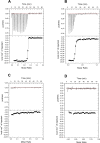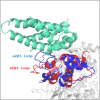Cullin 3 Recognition Is Not a Universal Property among KCTD Proteins
- PMID: 25974686
- PMCID: PMC4431850
- DOI: 10.1371/journal.pone.0126808
Cullin 3 Recognition Is Not a Universal Property among KCTD Proteins
Abstract
Cullin 3 (Cul3) recognition by BTB domains is a key process in protein ubiquitination. Among Cul3 binders, a great attention is currently devoted to KCTD proteins, which are implicated in fundamental biological processes. On the basis of the high similarity of BTB domains of these proteins, it has been suggested that the ability to bind Cul3 could be a general property among all KCTDs. In order to gain new insights into KCTD functionality, we here evaluated and/or quantified the binding of Cul3 to the BTB of KCTD proteins, which are known to be involved either in cullin-independent (KCTD12 and KCTD15) or in cullin-mediated (KCTD6 and KCTD11) activities. Our data indicate that KCTD6(BTB) and KCTD11(BTB) bind Cul3 with high affinity forming stable complexes with 4:4 stoichiometries. Conversely, KCTD12(BTB) and KCTD15(BTB) do not interact with Cul3, despite the high level of sequence identity with the BTB domains of cullin binding KCTDs. Intriguingly, comparative sequence analyses indicate that the capability of KCTD proteins to recognize Cul3 has been lost more than once in distinct events along the evolution. Present findings also provide interesting clues on the structural determinants of Cul3-KCTD recognition. Indeed, the characterization of a chimeric variant of KCTD11 demonstrates that the swapping of α2β3 loop between KCTD11(BTB) and KCTD12(BTB) is sufficient to abolish the ability of KCTD11(BTB) to bind Cul3. Finally, present findings, along with previous literature data, provide a virtually complete coverage of Cul3 binding ability of the members of the entire KCTD family.
Conflict of interest statement
Figures








Similar articles
-
A Comprehensive Analysis of the Structural Recognition between KCTD Proteins and Cullin 3.Int J Mol Sci. 2024 Feb 4;25(3):1881. doi: 10.3390/ijms25031881. Int J Mol Sci. 2024. PMID: 38339159 Free PMC article.
-
Structural Insights into KCTD Protein Assembly and Cullin3 Recognition.J Mol Biol. 2016 Jan 16;428(1):92-107. doi: 10.1016/j.jmb.2015.08.019. Epub 2015 Aug 31. J Mol Biol. 2016. PMID: 26334369
-
Molecular organization of the cullin E3 ligase adaptor KCTD11.Biochimie. 2011 Apr;93(4):715-24. doi: 10.1016/j.biochi.2010.12.014. Epub 2011 Jan 13. Biochimie. 2011. PMID: 21237243
-
Cullin 3 and Its Role in Tumorigenesis.Adv Exp Med Biol. 2020;1217:187-210. doi: 10.1007/978-981-15-1025-0_12. Adv Exp Med Biol. 2020. PMID: 31898229 Review.
-
CRL3s: The BTB-CUL3-RING E3 Ubiquitin Ligases.Adv Exp Med Biol. 2020;1217:211-223. doi: 10.1007/978-981-15-1025-0_13. Adv Exp Med Biol. 2020. PMID: 31898230 Review.
Cited by
-
Molecular evolution of Keap1 was essential for adaptation of vertebrates to terrestrial life.Sci Adv. 2023 May 19;9(20):eadg2379. doi: 10.1126/sciadv.adg2379. Epub 2023 May 19. Sci Adv. 2023. PMID: 37205751 Free PMC article.
-
KCTD2, an adaptor of Cullin3 E3 ubiquitin ligase, suppresses gliomagenesis by destabilizing c-Myc.Cell Death Differ. 2017 Apr;24(4):649-659. doi: 10.1038/cdd.2016.151. Epub 2017 Jan 6. Cell Death Differ. 2017. PMID: 28060381 Free PMC article.
-
Cullin E3 Ligase Activity Is Required for Myoblast Differentiation.J Mol Biol. 2017 Apr 7;429(7):1045-1066. doi: 10.1016/j.jmb.2017.02.012. Epub 2017 Feb 24. J Mol Biol. 2017. PMID: 28238764 Free PMC article.
-
KCTD15 deregulation is associated with alterations of the NF-κB signaling in both pathological and physiological model systems.Sci Rep. 2021 Sep 14;11(1):18237. doi: 10.1038/s41598-021-97775-6. Sci Rep. 2021. PMID: 34521919 Free PMC article. Clinical Trial.
-
A Comprehensive Analysis of the Structural Recognition between KCTD Proteins and Cullin 3.Int J Mol Sci. 2024 Feb 4;25(3):1881. doi: 10.3390/ijms25031881. Int J Mol Sci. 2024. PMID: 38339159 Free PMC article.
References
-
- Skoblov M, Marakhonov A, Marakasova E, Guskova A, Chandhoke V, Birerdinc A, et al. (2013) Protein partners of KCTD proteins provide insights about their functional roles in cell differentiation and vertebrate development. BioEssays: news and reviews in molecular, cellular and developmental biology 35: 586–596. 10.1002/bies.201300002 - DOI - PubMed
-
- Birerdinc A, Nohelty E, Marakhonov A, Manyam G, Panov I, Coon S, et al. (2010) Pro-apoptotic and antiproliferative activity of human KCNRG, a putative tumor suppressor in 13q14 region. Tumour biology: the journal of the International Society for Oncodevelopmental Biology and Medicine 31: 33–45. 10.1007/s13277-009-0005-0 - DOI - PMC - PubMed
Publication types
MeSH terms
Substances
LinkOut - more resources
Full Text Sources
Other Literature Sources
Molecular Biology Databases

